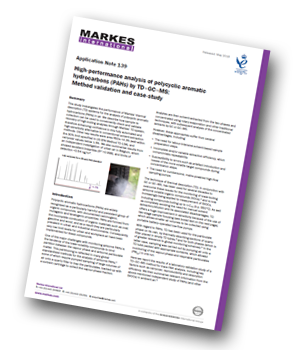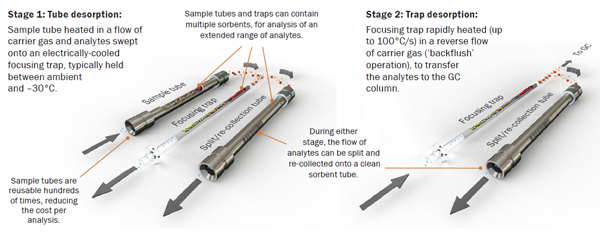This study investigates the performance of Markes’ thermal desorption (TD) systems for the analysis of polycyclic aromatic hydrocarbons (PAHs) in air.
 Summary
Summary
The application note describes how sample recollection can be used to conveniently check and validate recovery of high-boiling analytes through Markes’ TD system, therefore enhancing confidence in this fully automated and high-sensitivity alternative to conventional solvent-extraction methods. Other key results were area RSDs <4.3% (well within the 30% limit specified in US EPA Method TO-13A), and carryover values below 1.5%. Results from an independent investigation of urban air in Belgium are also summarized, which showed excellent linearities (R2>0.998), and limits of detection <0.54 ng/m3.
Introduction
Polycyclic aromatic hydrocarbons (PAHs) are widely recognised as a particularly harmful and persistent group of organic compounds, with documented carcinogenic, mutagenic and teratogenic properties. PAHs are formed from the incomplete combustion of organic materials such as coal, gasoline and wood, and as a result they are particularly prevalent in urban and industrial environments. Consequently, very low limit levels for urban and workplace air have been implemented for these compounds.
One of the major challenges with monitoring airborne PAHs is the tendency of the lower-volatility compounds to bind partition between the vapour phase and airborne particulate matter. This partitioning is reflected in many global standardised methods for the analysis of airborne PAHs, some of which require pumped sampling of large volumes of air onto a quartz filter to trap the particulates, backed-up with a sorbent cartridge to collect the vapour-phase fraction.
However, these approaches suffer from several disadvantages, including the need for labour-intensive solvent-based sample preparation steps; incomplete and/or variable extraction efficiency, which compromises repeatability; susceptibility to errors such as artefact introduction and losses of the more volatile target compounds during concentration steps and the need for cumbersome, mains-powered high-flow sampling pumps.
The technique of TD, in conjunction with GC or GC–MS, has been used for several decades to overcome these issues for the monitoring of lower-boiling airborne volatile organic compounds (VOCs), and is now increasingly being applied to measurement of SVOCs, including compounds boiling up to n-C44 (b.p. 550°C). As well as completely avoiding the need for manual solvent extraction/dilution and its associated disadvantages, TD offers a huge improvement in sensitivity because of the use of two-stage sample focusing (see below), which allows smaller air volumes to be collected using portable battery-operated low-flow pumps.
Background to thermal desorption
Thermal desorption is a versatile, solvent-free pre‑concentration technique for gas chromatography that is used to analyse volatile and semi-volatile organic compounds (VOCs and SVOCs) in air/gas, liquids and solids. By concentrating organic analytes present in air (or released from a sample) into a very small volume of carrier gas in a two-stage process (see below), TD maximises sensitivity for trace-level target compounds, helps to minimise interferences, and routinely allows analyte detection at the ppb level or below. It also greatly improves sample throughput, by combining sample preparation, desorption/extraction, pre-concentration and GC injection into a single automated process.

In this application note the results of a laboratory validation study of a TD–GC–MS method for trace PAH analysis, including key factors such as carryover, reproducibility and desorption efficiency are reported. Other relevant information is also summarized from the above-mentioned independent study of PAHs (and other SVOCs) in ambient air.
Results and discussion
Validation of analytical performance
Re-collection efficiency: Markes’ TD systems (manual and automated) are unique in allowing samples to be split and quantitatively re-collected onto a clean sorbent tube during tube desorption and/or trap desorption. Re-collected samples can then be re-analysed for validation of analyte recovery as described in key international standards. Quantitative re-collection of samples also overcomes the ‘one-shot’ limitation of traditional TD systems, and allows samples to be re-analysed under the same or different conditions – for example with a selective detector or at a different split ratio to extend the dynamic range.
Conclusions
These studies demonstrate that Markes’ TD systems – and specifically the TD100-xr automated thermal desorber used here – provide outstanding analytical performance for monitoring a range of PAHs in ambient and indoor air.
Key results from the validation study include very low carryover, excellent system reproducibilities (<4.5% RSD) and high desorption efficiencies. Use of Markes’ TD equipment in an independent analysis of urban air samples demonstrated excellent linearities (R2 >0.998) and excellent sensitivity for ambient air monitoring (limits of detection <0.54 ng/m3).




